Dear New York Weather: it’s almost June, and yesterday I was wearing a sweatshirt and I had the heat on. And it’s almost June! I understand you have your peculiarities, that you’re grappling with a diminishing ozone and toxic emissions, but I bought some cute new short sleeve shirts from UniQlo in SoHo (what a deal!) and I want to wear them, ok?
But in the meantime, I forgive you because if it weren’t for your unseasonable chill, would I have tried my hand at Coq au Vin, a traditional cold weather dish? The answer, I think, is no. And what a loss that would’ve been because this dish, this French classic of chicken braised in red wine, may be one of the best dishes I’ve ever cooked. We devoured it.
Of course, I’m a sucker for anything braised, especially when the recipe comes from the book whose praise I sing almost weekly here on the blog: Molly Stevens’s “All About Braising.” Cookbooks don’t get much better than this–I’ve never trusted a cookbook author more than I trust Molly Stevens. Her recipes, I imagine, are tested and tested and tested and that’s why they’re so flawless. And her Coq au Vin? It’s like a trip to France right there in your little kitchen.
The elements of Coq au Vin are fairly simple. There’s bacon, which you render, cooking the chicken in its fat; there’s the chicken, of course, which you should cut up yourself (it saves money and all the pieces are similarly sized), the aromatics–onion, carrot, tomato paste, garlic, parsley, thyme–and the alcohol, Cognac (which you shouldn’t skip: you can buy an airplane sized bottle at your liquor store), and, of course, the red wine. The resulting dish is so very rich and tender and deeply, profoundly flavorful. All hail, Molly Stevens.
The best part, though, is that if you’re just cooking for two there will be leftovers (a little goes a long way) and it tastes better the next day. Do what I did and boil up some egg noodles, toss them in butter, and serve the leftover Coq au Vin on top. It’d be great on a cold winter’s night or, in our case, a chilly, chilly Spring.
Coq au Vin
from Molly Stevens’s “All About Braising”
Ingredients:
1/4 pound slab bacon (I used D’Artagnan pancetta), rind removed, cut into 1/2-inch dice
One 4 1/2 to 5 lb chicken, cut into 8 pieces, wing tips, back, neck and giblets (except the liver) reserved
Coarse salt and freshly ground black pepper
All purpose flour for dredging (about 1/2 a cup)
3 tablespoons unsalted butter
1 large yellow onion (about 8 oz.), chopped into 1/2-inch pieces
1 carrot, chopped into 1/2-inch pieces
1 tablespoon tomato paste
2 tablespoons Cognac or other good brandy
One 750-ml bottle dry, fruity red wine (I used a Pinot Noir)
2 garlic cloves, peeled and smashed
1 bay leaf
1 tablespoon chopped fresh thyme
2 tablespoons chopped flat-leaf parsley
1 cup chicken stock
The garnish:
10 oz. pearl onions (about 24; frozen pearl onions, not thawed, may be substituted) [I used frozen and they worked great!]
2 1/2 tablespoons unsalted butter
3/4 pound cremini mushrooms, quartered
Coarse salt and freshly ground black pepper
2 tablespoons chopped flat-leaf parsley
1. The bacon. Place the diced bacon in a cold, large Dutch oven or other heavy lidded braising pot, set over medium heat, and cook the bacon, stirring often with a slotted spoon, until well browned and crisp on the outside but with some softness inside, 12 to 15 minutes. [I found my bacon wasn’t really rendering, so I added a drop of vegetable oil and that helped it.]
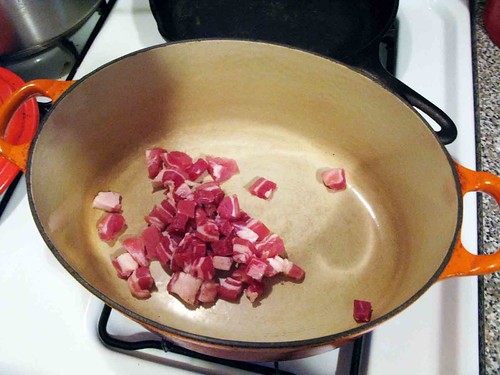
Transfer the bacon to a plate lined with paper towels. Set the pot with the rendered bacon fat aside off the heat.
2. Heat the oven to 325 degrees.
3. Rinse the chicken pieces with cool water and pat dry with paper towels. Season on all sides with salt and pepper [be aggressive here]. Spread the flour in a wide shallow dish (a pie plate works well), and dredge half the chicken pieces one at a time, pacing each one in the flour, turning to coat both sides, and then lifting and patting lightly to shake off any excess.
4. Add 1 tablespoon butter to the rendered bacon fat in the pot and place over medium-high heat. When the butter has melted, ease in the dredged pieces of chicken, skin side down, without crowding.

Sear on both sides, turning once with tongs, until a deep golden brown crust forms, 7 to 10 minutes total.
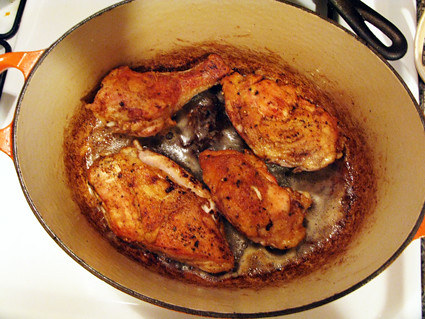
Transfer the chicken to a large platter; dredge the remaining pieces, discard the flour. Add another tablespoon butter to the pot, sear the remaining chicken. The second batch may brown faster, lower the heat if it begins to burn at all. Transfer the chicken to the platter, pour off the fat from the pot without discarding the tasty browned bits. Return the pot to medium heat.
5. Add the remaining tablespoon of butter and melt it over medium heat. Here’s what the bottom of your pan should look like:
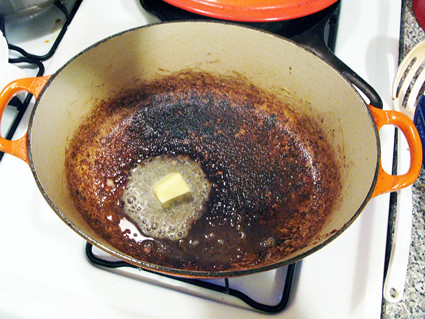
Add the onion and carrot, and toss to coat the vegetables in the butter. Saute, stirring once or twice, until the vegetables are beginning to soften and are flecked with brown, about five minutes.

Add the tomato paste and stir to smear the paste through the vegetables. Add the Cognac [be careful! don’t pour directly from the bottle] and bring to a boil to deglaze, scraping the pot with a wooden spoon to dislodge the precious crust. Simmer, stirring a few times, until the liquid is almost all gone. Raise the heat to high, add the red wine, garlic, bay leaf, thyme, and parsley, and bring to a boil. Lower the heat to medium-high and simmer rapidly until the wine reduces by about half, about 15 minutes.
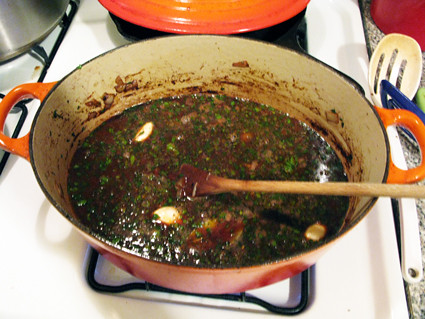
Stir in the reserved bacon and the stock and bring to a boil. Using a ladle, scoop out 1/2 cup of braising liquid and set aside for later cooking the pearl onions.
6. Add the chicken pieces to the pot in this order: place the legs, thighs, and wings, and the wing tips, back, neck, heart, and gizzard (if using [I didn’t!]) in the pot first, then put the breast pieces on top of them, skin side down. (Keeping the breast pieces on top protects them from overcooking and drying out.) Pour in any juices that collected as the chicken sat and bring to a simmer.
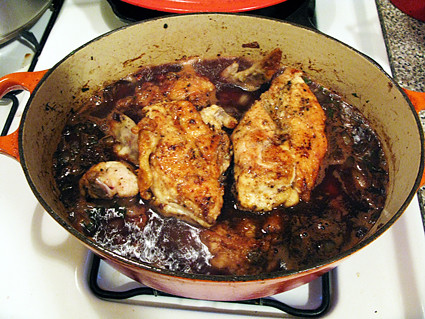
Cover the chicken with parchment paper, pressing down so that the paper nearly touches the chicken and extends over the sides of the pot by about an inch. Cover with the lid and place on a rack in the lower third of the oven to braise. After 15 minutes, turn the breast pieces over with tongs. At the same time, check that the liquid is simmering quietly. If not, lower the oven temp by 10 or 15 degrees. Continue braising gently for another 45 to 60 minutes, or until the breasts and dark meat are fork tender.
7. Meanwhile, while the chicken braises, cook the garnish. [I used frozen pearl onions for this, so I’m skipping her step for boiling and peeling fresh ones. Frozen work perfect!] Heat 1 tablespoon of the butter in a large skillet (preferably 12-inch nonstick) over medium heat. Add the onions and saute, stirring and shaking, until tinged with brown, 3 to 4 minutes.

Season with salt and pepper, add the reserved 1/2 cup of braising liquid, cover and simmer, shaking the pan frequently, until the onions are tender when pierced (3 to 4 minutes, if using frozen; 12 if not). Remove the lid, increase the heat to medium high, and boil to reduce the liquid to a glaze.

Transfer the onions and liquid to a small bowl, scraping the pan with a rubber spatula. Return the pan to a medium-high heat and add the remaining 1.5 tablespoons of butter. When the butter stops foaming, add the mushrooms, season with salt and pepper, and saute briskly. The mushrooms may release a lot of liquid at first. Continue to saute, stirring occasionally, until the liquid has evaporated and the mushrooms develop an attractive chestnut brown sear, about 10 minutes. Remove them from the heat and return the onions and liquid to the skillet. Set aside.

8. Take the chicken out of the oven. Look and smell, holy moly! [Those are my words, not Molly Stevens’s.]

Remove the chicken pieces to a platter, get rid of the giblets if you used them, and cover the chicken to keep it warm. Let the braising liquid settle and then skim off any fat from the top (I didn’t see any clear fat, so I just moved on). Place the pot over high heat and bring the juices to a boil. Reduce the juices until thickened to the consistency of a vinaigrette, about 10 minutes. Remove and discard the bay leaf.
Lower the heat, add the onion mushroom garnish, heat through, about 4 minutes.

Spoon the sauce over the chicken pieces, sprinkle with the chopped parsley, and serve.
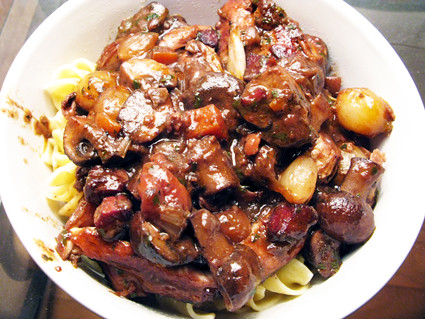
* * * * *
Note: that last picture comes from the next night, when I reheated it and served it on egg noodles. Sorry for not wiping the bowl there; I was a little too busy salivating.
Bon appetit.

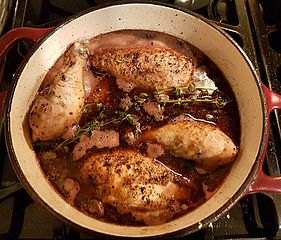
Leave A Comment
You must be logged in to post a comment.